Sonic The Hedgehog (1991) for Sega Genesis
- Sam Cawley
- Sep 1, 2021
- 7 min read
The blue blur known as Sonic The Hedgehog needs no introduction. Seeing huge success in the gaming industry and even moving onto the big screen with the Sonic The Hedgehog movie in 2020, Sonic is engraved into the hearts of children and adults alike.
The Sonic series has definitely slowed down over the years though, seeing fewer entries per year and typically receiving mixed reviews upon a new release. Sega is still keen to keep their mascot in the spotlight though, and one of their favourite ways to do that is re-release his older titles, whether it be a standalone release or a number of his games featured in a compilation of sorts.
With this in mind, and with the year of 2021 being Sonic's 35th anniversary, I thought I'd boot up my Genesis and take another look at Sonic's first appearance, looking how well it's held up, and if it still lives up to that promise of speedy, platforming fun 35 years later.

History
As always I'll start by looking at the history of Sonic, where he came from, a few interesting facts about the makings of the game and how well it was received overall.
Now back in the 80s and 90s Sega was no stranger to the gaming market. They were mainly known for their arcade titles like Phantasy Zone, Altered Beast and Space Harrier to name a few. They had a home console by this point as well, the Sega Master System, which had some success, but they were no where near the success of their main competitor, Nintendo. Games like Super Mario Bros were just more appealing to the masses, so Sega needed their own mascot, one that could rival Nintendo's. The then president of Sega, Hayao Nakayama stated that he wanted a mascot as iconic as Mickey Mouse, so the bar was set very high for their design team.
Development on the first game started before Sonic was even created, and while development was taking place, they decided the overall theme would be speed and decided to think of an animal character that would be known for being fast. This then escalated to an animal that could move fast but also roll up into a ball, and the perfect fit for those designs would obviously be a hedgehog.
And with that, they had a mascot, a hedgehog that would be known for his speed, coloured blue so that he'd stand out against background colours as well as suit the Sega logo's blue colour scheme. Finally he was given the name Sonic to match the theme of moving quickly, further development on the game continued.

The code name of the game was actually called "Defeat Mario" and designed around matching Mario's run speed and creating levels to compliment it. Yuji Naka, the project lead was actually inspired by Mario's simplicity in the way he was controlled and opted to keep that simplicity but with a more action oriented theme that would be fun for hard-core and casual gamers alike.
Sonic The Hedgehog released for the Sega Genesis in 1991, but also for the Sega Master System in an 8-bit version, as opposed to the Genesis' 16-bit version. Both games are fairly similar, with the Master System version being simplified to suit the consoles processing power and graphical capabilities.

Sonic was received extremely well by consumers. With glowing reviews from critics, and the desired comparisons to Nintendo's Mario, the game was a success, with the only main critique being the difficulty, with some believing it be far too difficult at times. However, overall it was a win for Sega, and gave them their boost of speed in the race with Nintendo.
Story
The game's premise is simple. An evil scientist named Dr Robotnik is in search of six powerful jewels called the Chaos Emeralds. In his pursuit of the emeralds, Robotnik has transformed and captured the wildlife of the islands the jewels are located, holding them captive in large metal capsules, or changing them into robots that act as the game's enemies. It's upto Sonic to save the day by finding the emeralds himself, freeing the captive animals, and stopping Robotnik.

Gameplay
It wouldn't be a Sonic game without fast paced gameplay, so naturally I'm going to talk about that first. The full potential of speed in this game is perfectly realised in it's first level, Green Hill Zone Act 1. In terms of first levels in videogames, there aren't many as iconic as Green Hill Zone. Aside from the popping colours and the classic soundtrack, this level shines with how it demonstrates what Sonic can do.
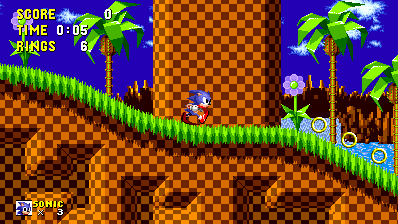
The layout is designed with lots of straight paths, loops, springs to bounce on and high speed tunnels, with very few serious obstacles. Yuji Naka was heavily inspired by Super Mario Bros first level when creating this one. He described playing the first level repeatedly trying to get through as fast as possible and found a lot of enjoyment in beating his best times. This shows in Green Hill as after a few attempts where you learn the layout you can blast through in under a minute. This momentum continues into Act 2 until it slows down for a boss fight in Act 3. These first three levels are amazing in terms of game feel and game design and Sega obviously have a lot of affinity for them as they throw a Green Hill inspired stage into every game it can fit into.
Unfortunately in later levels the game slows down quickly. The second level, Marble Zone, is the worst for this in my opinion, especially playing it immediately after Green Hill. The platforming becomes very slow and clunky, with this lava segments you have to stand on a block that drifts across to get where you need to go. There are still segments that let you blitz through the level, but the drag on the gameplay becomes apparent as you to progress through. What's even more jarring is there are parts where the game punishes you for going too quickly, often having traps and enemies in your direct path as you run through, with only small reaction windows to avoid them before they stop your momentum completely.
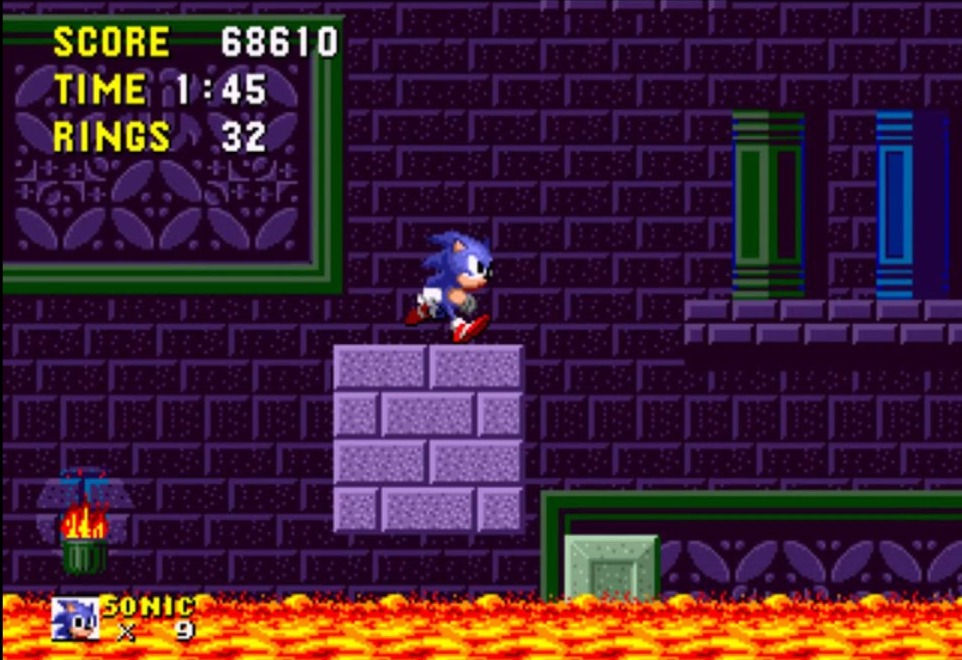
Momentum is another issue. When you're slowed down to a stop, it takes a second or two to really get moving again. Combine this with being on a slope and it becomes nearly impossible to get up the incline so you have to run backwards and then build up enough speed to charge up, just to get hit and slow to a crawl yet again. Now I don't want this to come across as overly negative, because I do actually like this game. I just think it doesn't live up to it's theme of speed all too well. There are plenty of times when you can race down a path and enjoy rushing through, but the majority of the time you'll just be platforming.
Luckily the platforming feels pretty good. Sonic controls well and his jumps feel weighty enough to know where you're going to land and in terms of enemy placement it feels satisfying to mow down enemies. You can do this by either jumping onto them or rolling into them, both of which put Sonic in his spiky ball form. You're not invincible though, Sonic needs to collect rings found through the level. These act as an extra hit which scatters your rings on the ground to be picked up again if you're fast enough.
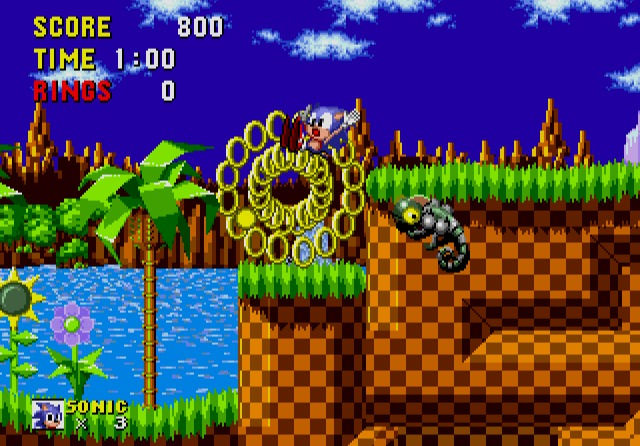
The levels themselves are designed well enough, with an exception being the last three, which crank the difficulty upto eleven and gave me a lot of trouble. Getting a game over sends you right back to the beginning too so it can get pretty frustrating after a few goes. While the levels are designed well in how they function, they fall in their presentation. I personally don't find them very memorable. Green Hill Zone, Marble Zone and Spring Yard Zone are the only memorable ones for me. Later games felt much more distinct in their variety and it felt like you were running through new areas, whereas in this one a lot of feels too similar without too much distinction, but like I said they're designed in a functional way which is what I think matters most.
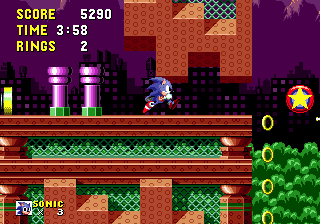
As mentioned earlier, Sonic is trying to find the Chaos Emeralds before Robotnik does, and to do this you need to enter special stages. You can do this by progressing to the end of a level while holding 50 or more rings. Then you have to jump through the large gold ring found at the end of the level.

Jumping through this transports you to a wacky, colourful pinball feeling stage with your objective being to break into the middle section by hitting the blocks surrounding it enough times. The stage rotates with their being exits at the edges which you want to avoid as this will end the bonus stage and you'll have to try again when you finish a level with 50 rings.
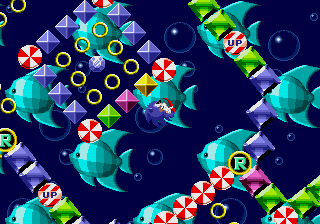
Upon claiming all the Chaos Emeralds you get a better ending screen when you beat the game, that's it. There's not much incentive to collect them all really but you can if you want to be a completionist or fancy the challenge.
Audio
The sound design for Sonic The Hedgehog is masterful. Comparing it to other Genesis game soundtracks and even some Nintendo game soundtracks it's rarely beaten on quality.
Music is fun and lively, packing in that feel good atmosphere that Sonic was supposed to represent. This has continued for nearly every Sonic game in existence, regardless of the game itself, the soundtracks are hardly ever out of place.
Effect sounds are equally impactful. Whether it's losing your stash or rings and hearing that loud clanging noise as they hit the ground, the speed up sound as you race down a tunnel, the "boing" as you hop onto a spring, it all comes together beautifully. The nostalgia fans of the series feel regarding the first few games are usually summarised by how memorable the sound design was and it's still a delight to experience to this day.
Conclusion
I feel like I've been a little over critical with Sonic The Hedgehog, but I don't want to give the impression I dislike the game or the character. I adore this game for what it is, the first Sonic game, and the memories of playing this as a child through the Nintendo Wii's virtual console will always stick with me, as I was determined to beat it but just didn't have the skill required. Nowadays I find it much easier and I always have fun whenever I pick it up for a few levels. It's execution of being a game about going fast is flawed but when it does give you the opportunity to race through a stage, it's wonderful, it's a just a shame it gets bogged down by incredibly slow segments.
If you're eager to pick this game up for yourself for the first time or to revisit it, you're in luck. Sega absolutely love re-releasing this game and it's sequel Sonic 2. You can find it on Nintendo consoles, Playstation, Xbox, and even your smartphone which is oddly the best version to play. It's good to pick up and play for a little while so I'd always recommend it, but if you're wanting to enjoy a true Sonic adventure, there are more appealing options.
And with that I'm going to end this post here and thank you for reading, hope you enjoyed and stay tuned for more posts, take care!







Comentarios